(VOVworld) – Located 120 km from Hanoi, Tam Coc-Bich Dong is part of the Hoa Lu limestone mountain range. For hundreds of years, the place has preserved the primitive beauty that has attracted countless visitors.
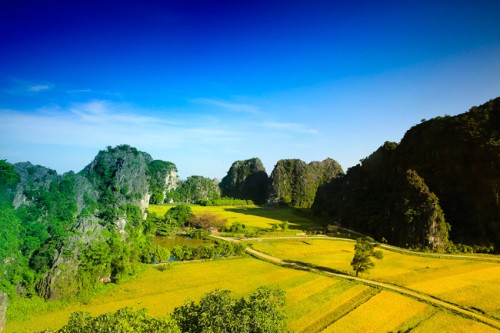 |
| Tam Coc means “Three caves”. These caves were made due to the transformation of geology, seawater and rainwater that have worn cliffs in a long period of millions of years |
The Tam Coc complex includes Tam Coc and Bich Dong, which are situated in Van Lam village, Hoa Lu district, Ninh Binh province. Recognized as a special national heritage, Tam Coc is often called ‘Ha Long Bay on the land’ for its system of limestone grottoes and historical relics from the Tran dynasty in the 13
th and 14
th century.

Charming scenery on the wharf of Tam Coc |
To reach Tam Coc, you must board a small boat at the wharf and get rowed up the sinuous Ngo Dong River past Xuyen Thuy cave and pockets of rice fields. Do Thi Nu, a local boat pilot, talked to us about Tam Coc’s history: “
In Chinese, ‘Tam’ means three and ‘Coc’ means cave, so ‘Tam Coc’ means three caves. In Vietnamese, it is called ‘Ba hang’. Hang Ca is the first cave, ‘hang Hai’ is the second cave, and ‘hang Ba’ is the third cave. It takes 2 hours to visit all three caves.”
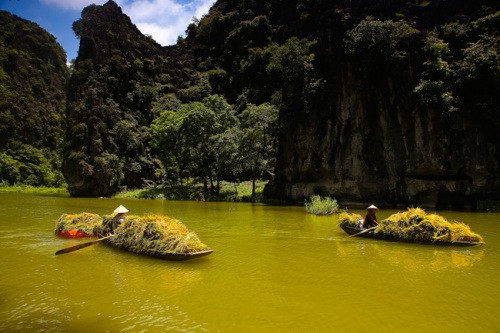 |
| Visit Tam Coc this season, You can easily see many images of farmer carrying rice |
Tam Coc is charmingly beautiful in any season. In spring, bright green rice fields spread along the river banks, turning into silky yellow beds in the fourth lunar month. In the summer while traveling on the Ngo Dong River, visitors will enjoy an enticing lotus fragrance while listening to the locals recounting legends about each cliff or mountain in the shape of a tortoise or dragon head.
There are particularly interesting rock formations, and schools of fish swimming in crystal clear water, but undoubtedly the most impressive features of Tam Coc are the caves, according to tour guide Nguyen Xuan Nguyen:
“Hang Ca is the first cave and the largest of the 3. It is 127 meters long and its mouth is 20 meters wide. Many stalactites hang down from the ceiling, some of which look like clouds and some of which drip water all day and are compared to a mother’s breast. The cave looks very dark from the outside, but the further you go into it, the brighter it is.”
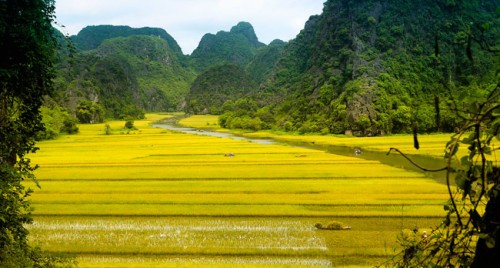 |
| Ngo Dong River is surrounded by fields and limestone mountains stretching endlessly. |
The beauty of Tam Coc is the beauty of the 3 caves with the Ngo Dong River running through them. The second cave, Hang Giua, which is about 10 minutes from the first cave, has a length of 60 meters and a multitude of flat, horizontal stalactites. The third and final cave, Hang Cuoi, is the smallest. It is about 50 meters in length and is only 100 meters from the second cave.
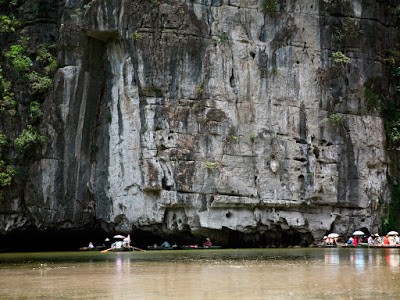 |
| Entrance to the caves of Tam Coc |
Its geology suggests this place was under the sea millions of years ago. The land emerged gradually over centuries and waves eroded the limestone mountains to form grottoes.
After the 2-hour excursion returns you to Tam Coc wharf and go an additional 2 km to Bich Dong, considered the second most beautiful cave in Vietnam. The Bich Dong area consists of a cave and a pagoda built on a limestone hill in 1428 under King Le Thai To. Ms. Nguyen again:
“Bich Dong pagoda is composed of 3 structures: Ha Pagoda (lower pagoda), Trung Pagoda (Middle pagoda), and Thuong Pagoda (upper pagoda). In 1740, King Le Canh Hung named the pagoda ‘Bach ngoc thach son dong’ which means pagoda made of beautiful stones like a sapphire in a remote place. ‘Bich Dong’ means “green grotto”, a name given by Nguyen Nghiem, the father of the great poet Nguyen Du, in 1773.”
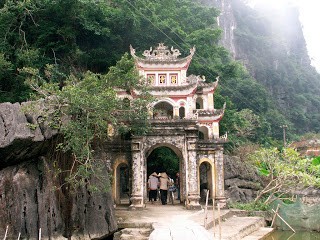 |
| Bich Dong Pagoda in Tam Coc |
After praying to Buddha in Bich Dong Pagoda, visitors climb 21 stone steps to Toi cave (Dark cave) whose stalactites are shaped like fairies, errand-boys, hovering dragons, swimming tortoises, elephants, and tigers. 40 more steps take you to go to the Upper Pagoda, from where you can enjoy the best views of Bich Dong. The view has strongly impressed foreigners like Monttie Binotto from Switzerland.
“This is my first time visiting this place, which is known for its cultural and historical tradition. Tam Coc-Bich Dong is favored by nature with friendly people and charming landscapes. I want to stay here for two or three days to fully explore it. I’m impressed by the smiles of boat drivers who can row the boats with their legs. I don’t think I can see these things anywhere else.”